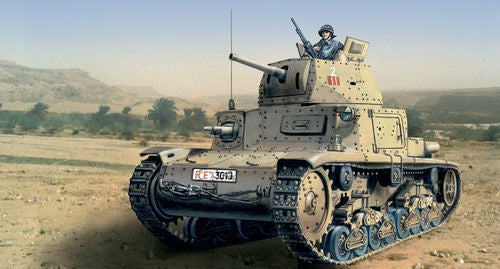Italeri 1:35 Carro Armato M13/40 (LW)
Italeri 1:35 Carro Armato M13/40 (LW) is backordered and will ship as soon as it is back in stock.
Couldn't load pickup availability
Delivery and Shipping
Delivery and Shipping
We use tracked courier for fast delivery New Zealand wide
Description
Description
The Carro Armato M13/40 was an Italian World War II tank designed to replace the M11/39 in the Royal Italian Army at the start of World War II. It was the primary tank used by the Italians throughout the war. The design was influenced by the British Vickers 6-Ton and was based on the modified chassis of the earlier M11/39. Production of the M11/39 was cut short in order to get the M13/40 into production. The name refers to "M" for Medio (medium) according to the Italian tank weight standards at the time, 13 tonnes was the scheduled weight and 1940 the initial year of production.
The M13 was constructed of riveted steel plates as follows: 30 mm front (as the M11), 42 mm on turret front (30 mm for the M11), 25 mm on the sides (the M11 had only 15 mm), 6 mm bottom (making it very vulnerable to mines) and 15 mm on top. The crew of four were housed in a forward fighting compartment, with the engine at the rear and transmission at the front. The driver and machine-gunner/radio operator were in the hull, with the commander/gunner and the loader in the turret.
The Vickers-derived running gear had two bogie trucks with eight pairs of small wheels on each side, using leaf-spring suspension. The tracks were conventional skeleton steel plate links, and were relatively narrow. Together, this system was thought to allow good mobility in the mountainous areas in which future combat was expected. In the desert where most M13s were actually employed, mobility was less satisfactory. The tank was powered by a 125 hp (93 kW) diesel engine. This was an innovation that many countries had yet to introduce, as diesel engines were the future for tanks, with lower cost, greater range and reduced danger of fire compared to petrol engines.
The tank's main armament was a 47 mm gun, a tank mounted version of the successful Cannone da 47/32 M35 anti-tank gun. It could pierce about 45 mm (1.8 in) of armour at 500 m (550 yd); this was sufficient to penetrate the British light and cruiser tanks it faced in combat, though not the heavier infantry tanks. One hundred and four rounds of mixed armour-piercing and high explosive ammunition were carried. The M13 was also armed with three or four machine-guns: one coaxially with the main gun and two in the forward, frontal ball mount. A fourth machine gun was sometimes carried in a flexible mount on the turret roof for anti-aircraft use. Two periscopes were available for the gunner and commander, and a Magneti Marelli RF1CA radio was also fitted as standard equipment.
Payment & Security
Payment methods
Your payment information is processed securely. We do not store credit card details nor have access to your credit card information.




